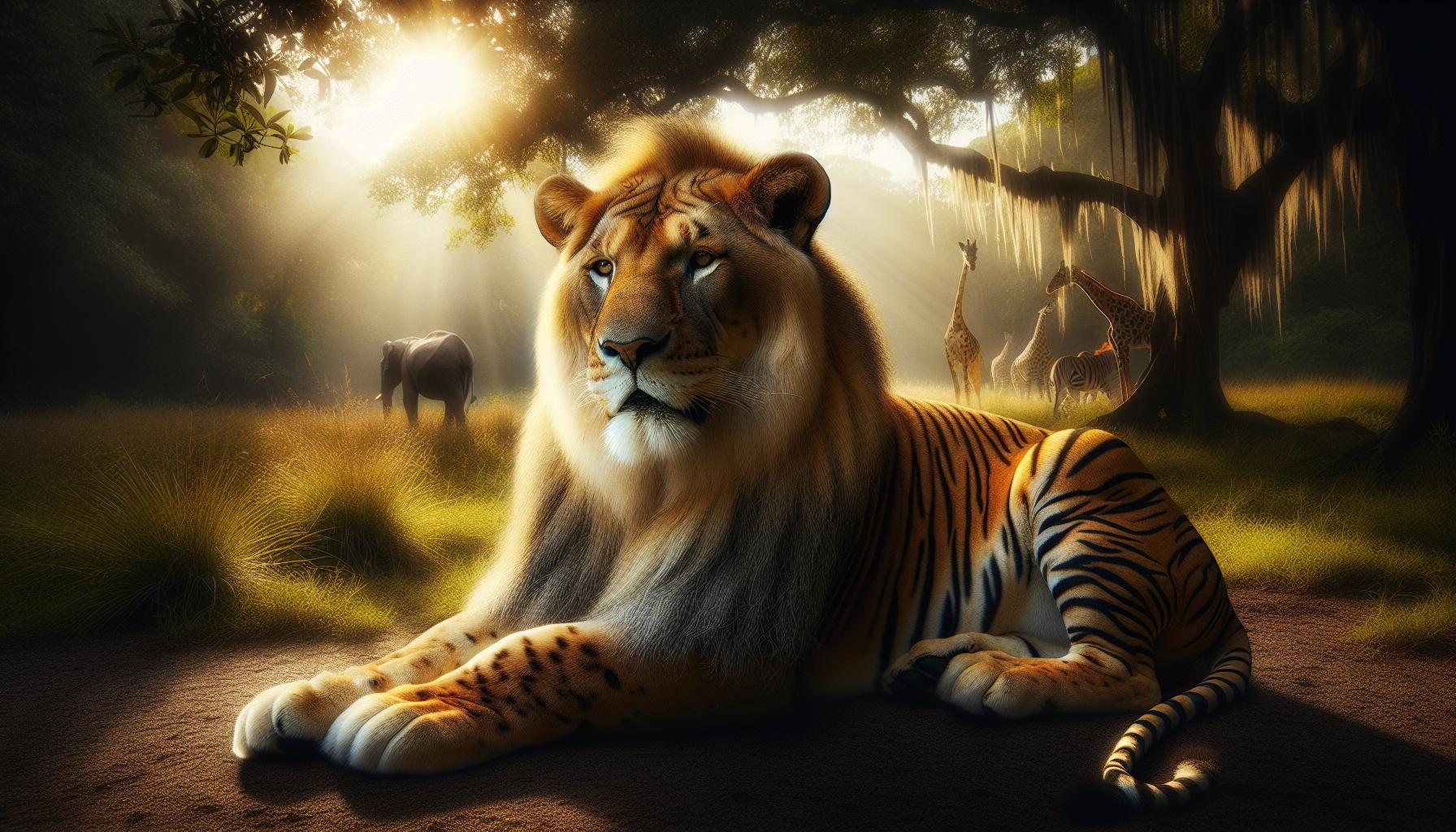Imagine a majestic creature that combines the strength of a lion with the grace of a tiger-the liger. This fascinating hybrid results from crossing a male lion with a female tiger, creating an animal that captivates both wildlife enthusiasts and curious minds alike. Understanding ligers isn’t just about their unique physical traits; it’s a gateway to broader discussions on hybridization in the animal kingdom and its implications for conservation and biodiversity.
As you explore the world of ligers, you’ll uncover intriguing facts about their size, behavior, and the ethical considerations surrounding their breeding. Whether you’re a budding zoologist or simply an animal lover, delving into the science behind these hybrids sheds light on nature’s complexities and the responsibility we hold in respecting wildlife. Join us on this journey to better understand what ligers are and why they matter to both the natural world and our own curiosity about the animal kingdom.
Contents
- 1 What are Ligers and How Do They Form?
- 2 The Genetic Makeup of Ligers Explained
- 3 Physical Characteristics: What Makes Ligers Unique?
- 4 Behavioral Traits of Ligers: A Closer Look
- 5 Ligers in the Wild vs. Captivity: Survival Insights
- 6 The History of Ligers: Origins and Evolution
- 7 Debunking Myths About Ligers: Facts vs. Fiction
- 8 Ethical Considerations of Breeding Ligers
- 9 Caring for Ligers: What You Need to Know
- 10 Famous Ligers in Popular Culture
- 11 Conservation Status: Ligers and Wildlife Preservation
- 12 Future of Hybrid Big Cats: Trends and Implications
- 13 Q&A
- 14 In Conclusion
What are Ligers and How Do They Form?
Ligers are one of nature’s most intriguing hybrids, resulting from the mating of a male lion and a female tiger. This distinctive breed captivates many due to its sheer size and unique characteristics, often weighing over 800 pounds and measuring up to 10 feet in length, making it the largest of all feline species. Ligers are typically bred in captivity, as their parent species inhabit different natural environments; lions are native to Africa while tigers are primarily found in Asia.
The creation of a liger primarily occurs in a controlled setting, particularly within zoos and wildlife parks. Due to the genetic compatibility of lions and tigers, their mating can lead to successful offspring despite their differing habitats. It’s important to note that ligers do not occur naturally in the wild; their existence largely reflects human intervention and breeding practices. This hybrid formation typically happens when a male lion and a female tiger are kept in close proximity, leading to mating opportunities that wouldn’t occur under natural circumstances.
In terms of reproductive biology, both lions and tigers belong to the same genus, Panthera, allowing for the hybridization that creates ligers. The combination of their genetic material results in unique traits that are a fascinating study in animal genetics. This convergence raises questions about the implications of hybrid creation, both from a biological and ethical standpoint. Understanding how ligers form emphasizes the often complex relationships between various species and the impact of human choices in wildlife conservation and management.
The Genetic Makeup of Ligers Explained
The intricate genetic makeup of ligers is a fascinating subject that illustrates how hybridization can produce unique combinations of traits from two distinct species. Ligers, the result of a mating between a male lion and a female tiger, showcase genetic similarities and differences that contribute to their remarkable physical attributes and behavioral traits. Both parent species, members of the Panthera genus, share a significant portion of their genetic code, which allows for this hybridization despite their different evolutionary paths and habitats.
When lions and tigers breed, the resulting liger inherits genetic material from both sides, leading to a mixture that can sometimes amplify certain traits. For instance, ligers often grow larger than both parent species due to a phenomenon known as hybrid vigor or heterosis. This can be attributed to the lack of genetically similar competition from their parents, allowing the offspring to develop enhanced growth and size characteristics. In stark contrast, tigons, the hybrids of female lions and male tigers, tend to be smaller and display different physical and behavioral characteristics.
Researchers have noted that ligers carry about 50% of their genetic material from each parent species, but some genes may be expressed differently. For example, the size of ligers is significantly influenced by growth-regulating genes from their parent species. Ligers tend to have a less pronounced growth restriction seen in both lions and tigers, leading to their much larger dimensions. Additionally, unique behavioral traits may emerge from genetic mixing, though studies on the specific behaviors of ligers-especially in captivity-have just begun to enrich our understanding of these hybrids.
While the genetic structure of ligers is remarkable, it presents some ethical concerns regarding their breeding in captivity. The absence of ligers in the wild underscores the necessity for responsible breeding practices to avoid health complications and ensure the welfare of the individuals involved. Understanding their genetic makeup not only serves to deepen our appreciation of these hybrids but also emphasizes the importance of ethical considerations in the realm of wildlife management and conservation.
Physical Characteristics: What Makes Ligers Unique?
The liger is a stunning embodiment of hybrid vigor, displaying a unique blend of physical characteristics inherited from its lion and tiger parents. One of the most striking features of ligers is their size; they are the largest big cats in the world. Males can weigh between 400 to 700 pounds, with some exceptional individuals reaching up to 1,000 pounds, considerably larger than both lions and tigers [2[2]. Their remarkable size is attributed to a combination of genetic factors that limit the growth restrictions found in both parent species, allowing the liger to grow larger than either parent.
Ligers tend to exhibit a lion-like appearance but with distinct features borrowed from tigers. Their fur is often sandy or golden like that of a lion, but it may also have faint stripes reminiscent of tiger markings. This intermingling of traits creates a captivating visual that emphasizes their hybrid status. Their bodies are generally muscular and long, with a broader head and larger paws compared to both lions and tigers, which contributes to their impressive stature [3[3].
Another fascinating aspect of ligers is their mane. While male ligers can grow a mane similar to lions, it may not be as developed or prominent. Instead, their mane tends to be thinner and less fluffy, showcasing a blend of characteristics. The evolutionary background of ligers gives them unique adaptations; for example, their paws are larger than those of either parent species, enabling greater strength and adaptability.
In addition to their size and appearance, ligers exhibit behavioral traits influenced by their genetic heritage. They are known for their friendliness and sociable nature, often displaying playful behaviors reminiscent of both lions and tigers. This combination of physical traits and personality makes ligers a subject of fascination for animal lovers and researchers alike. Whether you’re observing a liger’s playful leaps or admiring its impressive girth, it’s clear that this hybrid animal commands attention and respect in the animal kingdom.
Behavioral Traits of Ligers: A Closer Look
Ligers are not only remarkable for their size but also for their distinctive behavioral traits that emerge from their unique lineage. This captivating hybrid, born from the union of a male lion and a female tiger, tends to inherit a blend of characteristics from both parent species. One notable aspect of ligers is their inherently sociable nature. They display an unusually friendly demeanor compared to typical big cats, making them more inclined to engage in play and companionship. Observations suggest that ligers enjoy social interactions, often exhibiting a playful spirit that mirrors the more sociable tendencies of lions.
In terms of playfulness, ligers can be strikingly similar to both parent species. They partake in activities such as chasing, pouncing, and wrestling, allowing them to express their energy and develop essential social skills. Ligers tend to engage with their caretakers and fellow ligers, often displaying behaviors seen in lion prides, such as grooming and nuzzling, which strengthens social bonds. This unique social structure may facilitate positive experiences in captivity, contrasting with the more solitary nature of tigers.
Despite their impressive size, ligers are known for their docility. Studies and anecdotal evidence indicate that they are generally less aggressive than their tiger counterparts. This temperament makes them intriguing subjects for both animal behaviorists and enthusiasts alike. Their calm demeanor, coupled with their playful antics, often evokes a sense of endearment and fascination from observers, whether in a sanctuary or zoo environment.
Proper care for ligers is paramount to their well-being. Their social nature necessitates adequate enrichment and ample interaction to ensure they remain mentally and physically stimulated. When considering these exceptional animals, understanding their behavioral traits aids caretakers in providing suitable environments that foster their hybrid wonder-allowing them to thrive while showcasing their unique genetic inheritance.
Ligers in the Wild vs. Captivity: Survival Insights
In the world of exotic hybrids, ligers-offspring of male lions and female tigers-represent a fascinating blend of characteristics from their parent species. However, their very existence raises compelling questions about their survivability in the wild versus captivity. In nature, ligers would struggle to thrive. Born from a union that does not occur in the wild, these hybrids inherit a range of traits that may not lend themselves well to survival. For instance, ligers often face health complications due to their genetic makeup, and their size-which can exceed that of both lions and tigers-can hinder their agility and hunting prowess. They are typically sterile, which means they cannot reproduce and contribute to a population, further isolating them from the natural cycle of life in the wild.
In captivity, however, ligers can lead improved lives if provided with the right environments. Sanctuaries and zoos that prioritize their social needs often see positive outcomes, as these animals benefit from human care and structured social interactions. Unlike their solitary tiger grandparents, ligers display a penchant for companionship and group dynamics more akin to those of lions. They thrive in settings where they can interact with caretakers and each other, as this enrichment mitigates the risks of boredom and the psychological stress associated with confinement. Environments that mimic their natural habitats with ample space to roam and opportunities for play can help maintain their health and well-being.
Caring for ligers necessitates an understanding of their hybrid nature and unique behavioral traits. Providing adequate social interaction, as well as stimulating physical and mental activities, is crucial. For instance, regular engagement through play can help alleviate the potential issues associated with obesity, which can afflict these large cats. An effective enrichment strategy might include interactive toys, climbing structures, and space for athletic activities, reflecting their instinctive behaviors seen in the wild. Moreover, a balanced diet tailored to their specific needs will further enhance their quality of life and overall health.
In summary, while ligers are ill-equipped for existence in the wild due to their genetic inheritance and hybrid vigor, they can thrive in well-managed captivity. Their unique traits call for attentive care and a robust understanding of their needs, blending wildlife fascination with practical pet care guidance to ensure that these magnificent animals receive the attention and environment they require to flourish.
The History of Ligers: Origins and Evolution
From their striking appearance to their fascinating genetic lineage, ligers encapsulate a captivating chapter in the narrative of hybrid animals. The history of these hybrids, born from the union of a male lion and a female tiger, can be traced back to the late 1700s, primarily in India where the first known ligers were produced. This unusual interbreeding was not a natural occurrence; rather, it arose from controlled breeding efforts in captivity. These hybrids were primarily bred for entertainment and exhibit purposes, leading to the modern interest in their unique traits and characteristics.
Ligers are not just a marvel of chance; they embody the complex interplay of genetic traits from their parent species. Both lions and tigers inhabit different ecological niches, each with distinct behavioral and physical attributes. Lions, known for their social structures and pride behaviors, contrast sharply with the often solitary and stealthy nature of tigers. When these two majestic species unite, the offspring often display a fascinating blend of these traits. The hybrid vigor, which refers to the increased biological quality seen in hybrids, allows ligers to grow larger than either parent species. Both their potential size and unique combination of traits have made ligers a subject of both awe and controversy.
Despite their impressive size-typically reaching around 10 to 12 feet in length when fully grown-ligers face significant challenges due to their hybrid status. Most ligers are sterile, which represents a crucial aspect of their evolutionary narrative: they cannot reproduce, diminishing their long-term viability as a distinct population. This sterility stems from the fundamental genetic differences between lions and tigers, leading to complications during reproduction. As a result, the continuation of the liger lineage relies entirely on human intervention.
The ongoing interest in ligers highlights both the wonder of animal hybrids and the ethical considerations surrounding their breeding. As conservation efforts strive to protect natural populations of lions and tigers, the emphasis on responsible breeding practices for ligers raises important questions about animal welfare. As such, understanding the history and evolution of ligers not only enriches our appreciation for these extraordinary animals but also drives critical discussions about their place in wildlife conservation and the responsibilities of human caretakers.
Debunking Myths About Ligers: Facts vs. Fiction
Ligers, the remarkable hybrids resulting from the mating of a male lion and a female tiger, are often shrouded in misconceptions and myths that can obscure their extraordinary reality. One prevalent myth is that ligers are naturally found in the wild. In truth, ligers do not occur in the wild due to the differing habitats and non-overlapping ranges of lions and tigers. These magnificent creatures are entirely products of human intervention, typically bred in captivity for purposes of exhibition and entertainment. This controlled breeding raises ethical concerns, as these hybrids often exhibit health complications and behavioral issues that can be overlooked in the pursuit of novelty.
Another common myth is that ligers are ferocious beasts with limitless strength and aggression. While it’s easy to imagine a creature that combines the might of these two big cats as an apex predator, the reality is more nuanced. Ligers inherit a variety of behavioral traits from both lions and tigers, often combining the social nature of lions with the solitary tendencies of tigers. They are typically known to be gentle giants, exhibiting playful and friendly behaviors towards their caregivers. Understanding their temperament is crucial for those who admire these animals and seek to support their welfare.
The idea that ligers live longer than their parent species is another misconception. While hybrid vigor may result in some health benefits at birth, ligers frequently face various health challenges that affect their longevity, including obesity and organ problems due to their rapid growth. It’s essential to consider that a liger’s life expectancy is often compromised, reflecting the consequences of their hybrid nature.
Debunking these myths not only provides an accurate understanding of ligers but also emphasizes the importance of responsible animal care and breeding practices. Those enchanted by the idea of owning such an exotic pet should recognize the ethical implications and the potential challenges involved in caring for a hybrid animal with specific needs. By fostering a well-rounded knowledge of ligers, enthusiasts can appreciate these fascinating hybrids while advocating for their welfare in an increasingly complex world of wildlife conservation.
Ethical Considerations of Breeding Ligers
Breeding ligers raises profound ethical considerations that extend beyond the mere act of creation. These hybrids are often seen as novelties, yet their existence underscores significant welfare issues that arise from mixing species that do not naturally coexist. The creation of ligers, which occurs exclusively in captivity, frequently prioritizes entertainment and profit over the well-being of the animals. As a direct result of this human intervention, ligers can suffer from serious congenital defects, obesity, and a range of health complications, leading to markedly shorter lifespans compared to their lion and tiger counterparts. The question of whether it is justifiable to breed animals for such purposes is at the heart of this ethical debate.
One major concern is the inherent distress these hybrids face due to their breeding conditions. Ligers are typically raised in zoos or breeding facilities that lack the spacious environments and appropriate social structures found in their natural habitats. As a result, they can grow up isolated or in unsuitable conditions that do not cater to their physical and psychological needs. This confinement can lead to abnormal behaviors often linked to stress, such as stereotypic movements or aggression, which are far removed from the natural tendencies of both lions and tigers. Care should be given to understanding these behavioral traits, particularly for those considering studying, observing, or caring for these animals in captivity.
Furthermore, the ethical implications of breeding ligers also encompass the notion of conservation. While some proponents argue that hybrids like ligers can attract public interest and aid conservation efforts, this perspective is heavily contested. The reality is that the breeding of hybrids does not contribute to the conservation of either species; instead, it diverts attention and resources from the critical preservation of pure lion and tiger populations in the wild. The focus should ideally remain on saving their habitats and ensuring the survival of these species in their natural environments rather than producing hybrids that serve primarily as attractions.
Given these points, individuals who admire these extraordinary creatures must consider their responsibility towards their well-being. If one is inclined towards exotic pets or the idea of caring for a hybrid, it becomes essential to evaluate the ethical ramifications of such choices. Engaging with organizations that promote animal welfare and responsible breeding practices can help to ensure that any interest aligns with the ethical treatment of these fascinating animals. Awareness and advocacy for responsible animal stewardship can drive meaningful change in how we perceive and treat hybrids within the broader context of wildlife conservation.
Caring for Ligers: What You Need to Know
Caring for a liger is far more complex than caring for domestic pets, given their unique hybrid nature and considerable size. These majestic animals can grow to be larger than both their lion and tiger parents, often exceeding 600 pounds. Consequently, any engagement with ligers necessitates an understanding of their specialized needs, both physically and psychologically. If you’re a caretaker or simply passionate about wildlife, here are essential aspects to consider.
For those responsible for a liger, a spacious and enriching environment is critical. Given their size and natural instincts derived from their lion and tiger lineage, ligers require large enclosures that allow for extensive room to roam, explore, and engage in physical activity. These environments should mimic their natural habitats as much as possible, ideally incorporating climbing structures, water features for swimming, and ample shade. Such settings foster not only physical health but also mental well-being, which is crucial to prevent the development of abnormal behaviors stemming from confinement.
Nutrition is another important area of care. Ligers, being hybrid big cats, have dietary needs that can be specific and demanding. A balanced diet similar to that of both lions and tigers must be adhered to, typically consisting of high-quality meat sources such as beef, chicken, or specially formulated large cat diets. Additionally, it’s essential to monitor their weight and health closely, as ligers can be predisposed to obesity and related health issues, which can shorten their already limited lifespans. Regular vet checkups to assess health and dietary needs are non-negotiable.
Psychological Enrichment
Ligers, like their parent species, are intelligent and social animals that thrive on interaction. Without proper stimulation, they can develop negative behaviors. Providing varied enrichment activities is crucial. This can include:
- Interactive toys that encourage problem-solving and play.
- Regular training sessions using positive reinforcement to engage their natural intelligence.
- Socialization opportunities, being cautious not to mix them with incompatible species.
Creating an environment that encourages natural behaviors, such as stalking and pouncing, can significantly enhance a liger’s quality of life.
The responsibility of caring for a liger demands dedication and a comprehensive approach to their well-being. Understanding their intricate needs allows for a more fulfilling life for these magnificent hybrids while promoting ethical considerations in their care. Whether involved in formal captivity settings or personal interest in wildlife, awareness of their requirements ensures that ligers receive the respect and care they deserve.
Famous Ligers in Popular Culture
The liger, a mesmerizing fusion of lion and tiger, has captured the imagination of many and found its way into popular culture in intriguing ways. This unique hybrid has not only made its mark in zoological studies but has also appeared in films, art, and even viral internet memes, showcasing both its physical grandeur and its enigmatic nature.
One of the most famous ligers is Hercules, known for being one of the largest cats in the world, weighing around 900 pounds. Hercules, who resides at the Myrtle Beach Safari in South Carolina, has appeared in various documentaries and TV shows, likening his size to that of a small car. His sheer size and charming demeanor have made him an ambassador for the species, helping raise awareness about hybrid animals and the complexities surrounding their breeding. Interestingly, Hercules also demonstrates the fascinating yet controversial prospect of hybrid vigor, where ligers can exhibit some health benefits compared to their parent species, although these advantages come with increased health risks specific to hybrids.
Beyond the animal kingdom, ligers have made an impact on the cinematic landscape as well. Films such as “The Hangover Part II” humorously depict ligers as exotic pets, adding a layer of playful absurdity to the narrative. These portrayals have sparked curiosity and discussions about hybrids, often blurring the lines between fiction and reality. Additionally, social media platforms have seen liger images and memes gain traction, with witty captions and captivating visuals making these hybrids accessible to a younger audience, translating their grandeur into shareable moments.
The growing fascination with ligers also raises important ethical considerations around their breeding and care. As these creatures become symbols of hybrid wonder, discussions abound regarding the responsibility of handling such hybrids, particularly in terms of their welfare and conservation. While ligers can be captivating and thought-provoking, their existence prompts deeper questions about the role of human intervention in nature, urging audiences to reflect not only on their beauty but also on the implications of creating hybrid animals for entertainment or curiosity.
In understanding ligers through the lens of popular culture, it’s essential to balance admiration with awareness of their complex needs and challenges they face in captivity. As they continue to represent the extraordinary outcomes of hybridization, they also serve as reminders of the importance of ethical wildlife conservation practices and the responsibilities tied to the excitement we feel toward these magnificent creatures.
Conservation Status: Ligers and Wildlife Preservation
The continual rise in liger populations has sparked considerable debate within conservation circles, illuminating a complex intersection of ethics, preservation, and animal welfare. While ligers showcase the awe-inspiring result of combining lion and tiger genetics, their breeding and existence in captivity pose significant challenges to wildlife conservation efforts. As hybrids, ligers lack the clear conservation status associated with their parent species-lions and tigers, both of which face severe threats in the wild due to habitat loss, poaching, and climate change.
Ligers are typically bred in captivity, often for the entertainment and novelty they provide, rather than contributing to species preservation. This practice raises critical ethical questions: Does breeding these hybrids detract from efforts focused on saving endangered big cats? Conservationists argue that resources should be channeled into preserving wild populations and their habitats, instead of creating hybrids that cannot survive in the wild and have no role in the natural ecosystem. As such, they advocate for the protection of genetic diversity among pure species, emphasizing the importance of supporting wild lions and tigers in their diminishing habitats.
In captivity, ligers can also face a host of health problems attributed to their hybrid nature, such as organ failure and weakened immune systems. These health concerns highlight the necessity of thoughtful animal care and appropriate environments tailored to their unique needs, ensuring that their welfare is a priority within captive settings. Zoos and sanctuaries hosting ligers must adhere to high standards of care, involving spacious enclosures, specialized diets, and comprehensive veterinary support.
To contribute proactively to wildlife preservation, individuals passionate about big cats can engage in initiatives aimed at supporting conservation projects that focus on protecting natural habitats rather than breeding hybrids. This might include:
- Supporting organizations dedicated to wild tiger and lion conservation.
- Advocating against the captivity and breeding of hybrid animals.
- Educating others about the importance of preserving pure species for ecosystem balance.
In summary, while ligers stir fascination and wonder, their conservation status is complex and requires a nuanced understanding of ethical wildlife management. By prioritizing the preservation of their parent species and redirecting focus towards sustainable conservation practices, we can ensure that the majestic qualities of lions and tigers endure for generations to come.
Future of Hybrid Big Cats: Trends and Implications
As the fascination with hybrid big cats like ligers continues to grow, understanding the implications of their existence is becoming increasingly critical. These extraordinary animals, born from the union of a lion and a tiger, showcase an intriguing blend of power, majesty, and adaptability. However, their future is shadowed by numerous debates surrounding ethics, conservation, and animal welfare that must be considered.
The increasing popularity of hybrid big cats in captivity often leads to a troubling trend: more breeders are motivated by profit and spectacle rather than genuine conservation efforts. This commercialization can pose threats to endangered species, as resources that could be directed toward preserving natural habitats and supporting purebred populations become diverted into the care and breeding of hybrids without ecological significance. Experts argue that fostering awareness about the plight of wild lions and tigers facing extinction should take precedence over the allure of hybrid specimens.
In light of these trends, it becomes vital to advocate for sustainable practices and responsible animal husbandry. Caregivers and facilities housing ligers should prioritize the health and well-being of these hybrids, which often suffer from genetic ailments due to their mixed lineage. Providing environments that mimic their natural habitats is essential, balancing their nutritional needs and ensuring robust veterinary care. Recognizing the shortcomings of hybrid breeding, many conservationists stress that efforts should be concentrated on preserving pure species and their ecosystems rather than expanding populations of hybrids.
Looking ahead, the future of hybrid big cats hinges on a collective commitment to wildlife conservation. By championing efforts that emphasize the protection of endangered species and their habitats, ensuring ethical treatment in captivity, and fostering education around the complexities of hybrid animals, we can redirect focus from creating novelty to safeguarding the future of our planet’s most awe-inspiring felids. Supporting organizations dedicated to wild big cat conservation and promoting ethical wildlife practices will not only help maintain the integrity of our natural ecosystems but also ensure that the magnificence of lions and tigers endures for generations.
Q&A
Q: What is a liger?
A: A liger is a hybrid animal resulting from the mating of a male lion and a female tiger. This unique crossbreed inherits characteristics from both parent species, making it one of the largest big cats in existence. For more on how ligers are formed, explore our section on hybrid formation.
Q: Are ligers fertile?
A: Female ligers are fertile and can breed with either lions or tigers, while male ligers are typically sterile. This reproductive trait is common among hybrid species, influencing their population dynamics. Check out our article on genetic aspects for more details.
Q: How big do ligers get?
A: Ligers can grow significantly larger than both lions and tigers, often exceeding 900 pounds and reaching lengths of up to 11 feet. Their size results from a phenomenon known as parental growth hormone suppression. For insights on their physical characteristics, refer to our section on unique traits.
Q: Where do ligers live in the wild?
A: Ligers do not exist in the wild; they are exclusively bred in captivity. Their mixed lineage means they cannot survive in natural habitats effectively, as they lack the specific instincts required for survival in the wild. For more on their habitat, see our survival insights section.
Q: What do ligers eat?
A: Ligers are carnivorous and require a diet similar to both lions and tigers, consisting mainly of meat. Their diet may include various prey items found in zoos or wildlife facilities where they are housed. Our caring for ligers section offers more practical tips on their feeding.
Q: Can ligers roar?
A: Yes, ligers can roar, producing a sound that is a mix of a lion’s roar and a tiger’s growl. Their vocalizations showcase their unique hybrid nature, intriguing both scientists and visitors alike. For more on their behavioral traits, see the relevant section in our article.
Q: Why are ligers controversial?
A: Ligers face ethical concerns regarding their breeding. Critics argue that creating hybrids like ligers can lead to health issues and does not contribute to conservation efforts. To understand the ethical implications further, explore our section on breeding considerations.
Q: Are there famous ligers?
A: Yes, ligers have gained fame in popular culture, with notable examples like Hercules, who was known as the world’s largest liger. Such animals often capture public interest, raising awareness about hybrid big cats. For more on their cultural significance, check out our section on famous ligers.
In Conclusion
Ligers represent a fascinating intersection of the lion and tiger worlds, showcasing unique traits that intrigue animal lovers and enthusiasts alike. As you’ve learned, this hybrid not only captures our imagination with its impressive size and striking appearance but also reflects the complexities of animal genetics. Don’t let your curiosity stop here-explore our articles on other big cat hybrids, like tigons, or dive into the incredible lives of lions and tigers individually. Discover the intricacies of their ecosystems by visiting our wildlife section.
To stay updated on the latest insights into the world of exotic animals and hybrids, consider signing up for our newsletter. Share your thoughts or ask questions in the comments below-we love hearing from you! Join our community and continue your journey into the wonders of wildlife, fueled by knowledge and responsibility. Remember, understanding these majestic creatures can empower us to advocate for their conservation and well-being in the wild and in captivity.





